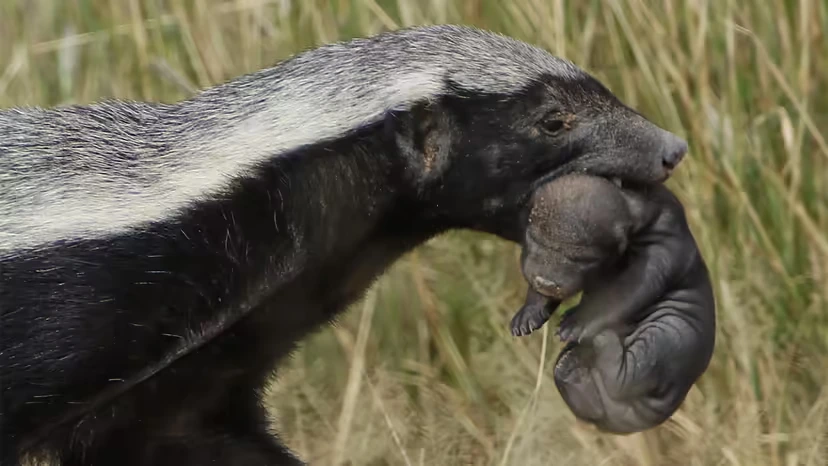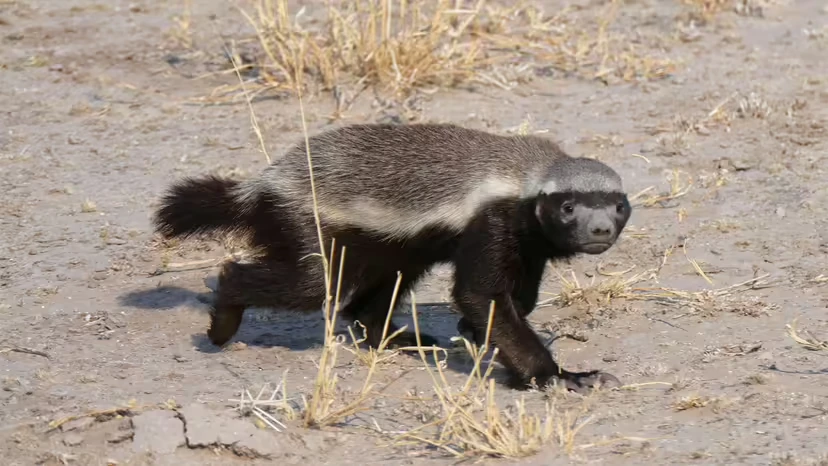At a glance
Species: Honey badger / ratel (Mellivora capensis)
Family: Mustelidae (weasel family)
Range: Most of sub-Saharan Africa, parts of North Africa, Southwest Asia, and India
Why famous? Viral clips made them legends of “don’t-care” ferocity—but the real animal is even more interesting (and harder to study).
Honey badgers aren’t “true” badgers in the European sense; they’re mustelids—closer to wolverines and weasels—wearing a bold two-tone coat with a pale cap running from head to tail. They’re compact, low-slung diggers (about 28 cm / 11 in shoulder height) with powerful forelimbs and ~4 cm (1.5 in) claws built for excavation, not sprinting.
They’re also notoriously difficult to study. Many individuals are nocturnal, they roam huge home ranges (males up to ~500 km² / 190 mi², sometimes even larger; females up to ~150 km² / 60 mi²), and they’re clever enough to avoid people and cameras.

Where they live: From dry savannas and deserts to woodland edges and farmland mosaics across Africa; smaller populations in SW Asia and India.
Solitary by default: Adults mostly travel alone. Females den and care for young; otherwise, encounters are brief and businesslike.
Scent posts & “latrines”: Individuals communicate via scent marking. Females in estrus will leave urine notes at shared sites to signal readiness to mate.
Calling them “omnivores” undersells it. Honey badgers will eat roots, fruits, beetle grubs, tortoises, small mammals, birds, eggs, and a remarkable amount of snakes (often cited at ~25% of the diet in some areas). They scavenge readily and dig for prey that faster carnivores miss. If it’s edible, they’ll try it—bee brood (larvae) included, which is why they raid hives.
Foraging style: Search, dig, pry, tear. They’ll squeeze into holes with their loose, thick skin and bulldoze burrows that defeat foxes or jackals—often leaving scraps for other scavengers trailing behind.
The myth: An indestructible, lion-fighting berserker.
The reality: A small carnivore with tough hide, loose skin (so it can twist and bite back if grabbed), and big tools for its size. Inexperienced predators—young lions, leopards, hyenas—sometimes learn once not to tangle with one. But honey badgers can be injured or killed; their best defense is a vicious counterattack and a refusal to quit.
Honey badgers regularly tangle with venomous snakes. They’re not magically immune to everything; rather, they show elevated tolerance—likely a mix of evolved receptor changes (so some toxins “don’t fit”) and learned exposure. Observers note mothers gradually introduce pups to more dangerous prey (from mild scorpions up to puff adders and cobras) over 14–18 months of rearing. Their resilience continues to inform antivenom research.

They possess an anal pouch with a pungent secretion. It’s not a skunk-style spray weapon; releases seem tied to stress or close-quarters conflict. The odor is extraordinarily strong (detectable at tens of meters). Some field workers suggest it may distract or deter attackers—or even affect bee behavior—but its main function is likely chemical communication.
Honey badgers don’t raid for honey so much as for the protein-rich brood. That historically led to significant conflict with beekeepers (broken hives, lost honey and swarms). A simple, effective fix has spread widely:
Raise hives off the ground (~1.1 m / 3.6 ft), and/or
Strap or cage hives together so they can’t be rolled or pried apart.
Since adopting badger-proofing, many regions have seen reduced persecution and rebounding local numbers. In South Africa, the species moved from near-threatened locally back to least concern as conflicts dropped.
Mating: Rarely observed in the wild; one territorial male will typically mate with multiple females in his range until displaced by a rival.
Young: Usually one (occasionally two) pups. Extended maternal care (14–18 months)—long for a carnivore of this size—likely underpins their problem-solving and prey handling skills.
Build: Low, stocky, powerful forequarters; broad head
Coat: Distinct pale “cap” from forehead to tail set over dark sides and belly
Tracks: Five toes front and back; long front claws leave clear marks; frequent digging sign
Sign: Discarded tortoise shells, raided termite mounds, torn hives, scent latrines
Global status: Least Concern (globally), with local declines where persecution and habitat loss persist.
Ecological value: As mesopredators and excavators, they turn soil, control rodents, redistribute nutrients, and create feeding opportunities for raptors and jackals that shadow them.
For beekeepers: Elevate and strap hives; use stands or tire-mounted bases; install simple wire exclosures.
For smallholders: Secure poultry at night; reinforce lower edges of enclosures (they dig).
For photographers: Expect nocturnal activity, wide ranges, and high trap-shyness—use scent lures sparingly and place cameras at dig sites, latrines, or water.
Are honey badgers immune to all snake venom?
No. They show notable tolerance to some venoms, but not universal immunity. Severe envenomation can still be dangerous or fatal.
Do honey badgers really attack lions?
They’ll stand their ground and counterattack when cornered. That boldness built their reputation, but engaging big cats is high-risk and not a strategy they “prefer.”
Why do they look so “loose-skinned”?
Their thick, loose hide reduces damage from bites and lets them twist inside a grip to bite back—crucial in tunnels and grapples.
Do they actually love honey?
They’ll eat it, but the real prize is bee brood (larvae/pupae)—dense protein and fat.
Are they intelligent?
Yes. Field reports and captive observations show tool use, latch-opening, problem-solving, and fast learning—hallmarks of clever mustelids.
Strip away the memes and you still have a remarkable, highly adaptable carnivore: small but shockingly capable, fearless when cornered, and essential to the ecosystems it patrols. The honey badger doesn’t “not care”—it just cares about solving problems, eating well, and surviving on its own terms.
animal tags: honey badger
We created this article in conjunction with AI technology, then made sure it was fact-checked and edited by a Animals Top editor.